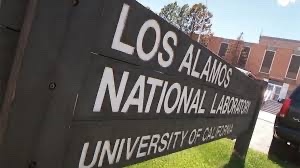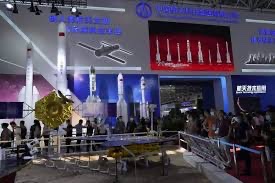

美國防部華人:在國內發展軍事技術!
– 參與中國軍事技術開發=至少154人-
洛斯阿拉莫斯國家實驗室:
在過去的 20 年裡,
至少有 154 名“曾在美國主要國防機構工作過的中國退休科學家”。
超音速,
深地穿透彈頭,
無人機,
噴氣發動機,
潛艇降噪。
中國退休科學家:
當前的,
退休後,這些中國科學家正在參與中國軍事技術的發展。
它為中國軍事技術的發展做出了貢獻。
美國 Strider 技術:
這在最近發布的最新報告中得到了強調。
中國推出了各種人才計劃,以在關鍵技術領域獲得優勢。
在加深了他在美國國防部的專業知識後,
國際學生,
研究員,
科學家,
從美國研究所退休後,他為中國軍事技術的發展做出了貢獻。
大紀元時報
https://mb.epochtimes.jp/2022/09/118669.html
Les Chinois à l’US Defence Agency : Développez la technologie militaire chez vous !
– Impliqué dans le développement de la technologie militaire chinoise = au moins 154 personnes –
Laboratoire national de Los Alamos :
depuis 20 ans,
Il y a au moins 154 “scientifiques chinois à la retraite qui ont travaillé dans les principales agences de défense américaines”.
- hypersonics,
- deep-earth penetrating warheads, UAVs,
- jet engines,
- submarine noise reduction.
Scientifique retraité chinois :
Courant,
Après leur retraite, ces scientifiques chinois participent au développement de la technologie militaire en Chine.
Il contribue au développement de la technologie militaire chinoise.
Technologies américaines Strider :
Ceci est mis en évidence dans le dernier rapport publié récemment.
La Chine a lancé divers programmes de talents pour gagner un avantage dans des domaines technologiques clés.
Après avoir approfondi son expertise au sein de la U.S. Defence Agency,
élève international,
chercheur,
le scientifique,
Après avoir pris sa retraite des instituts de recherche aux États-Unis, il a contribué au développement de la technologie militaire chinoise.
Epoch Times Epoch Times
Chinesen in der US-Verteidigungsbehörde: Entwickeln Sie Militärtechnologie zu Hause!
– Beteiligt an der Entwicklung von Militärtechnologie in China = mindestens 154 Personen –
Nationallabor von Los Alamos:
in den letzten 20 Jahren,
Es gibt mindestens 154 „chinesische Wissenschaftler im Ruhestand, die in wichtigen US-Verteidigungsbehörden gearbeitet haben“.
- hypersonics,
- deep-earth penetrating warheads,
- UAVs,
- jet engines,
- submarine noise reduction.
Chinesischer Wissenschaftler im Ruhestand:
Aktuell,
Nach ihrer Pensionierung beteiligen sich diese chinesischen Wissenschaftler an der Entwicklung von Militärtechnologie in China.
Es trägt zur Entwicklung von Chinas Militärtechnologie bei.
US Strider Technologies:
Dies wird in dem kürzlich veröffentlichten neuesten Bericht hervorgehoben.
China hat verschiedene Talentprogramme gestartet, um sich in wichtigen Technologiebereichen einen Vorsprung zu verschaffen.
Nach Vertiefung seiner Expertise bei der U.S. Defense Agency,
Internationaler Student,
Forscher,
der Wissenschaftler,
Nachdem er sich von Forschungsinstituten in den Vereinigten Staaten zurückgezogen hatte, hat er zur Entwicklung von Chinas Militärtechnologie beigetragen.
Epochenzeiten Epochenzeiten
“The Los Alamos Club:”
New Report Details
China’s Efforts to Recruit Leading U.S. Department of Energy Scientists to Advance Defense Technology Programs for the People’s Republic of China
Prevent intellectual property theft and supply chain vulnerabilities
Los Alamos National Laboratory alumni are driving key advances in military and dual-use technologies
for the PRC including in
hypersonics,
deep-earth penetrating warheads,
unmanned aerial vehicles,
submarine noise reduction
Salt Lake City, UT (September 22, 2022)
Strider Technologies, Inc.
today released a new report detailing
the People’s Republic of China’s decades-long recruitment of leading scientists from the U.S. Department of Energy’s Los Alamos National Laboratory in New Mexico.
The report’s findings are
the latest evidence of the PRC employing its broader Talent Superpower Strategy to incentivize Chinese academics, researchers, and scientists to go abroad, deepen their expertise, and return to advance China’s strategic interests.
Between 1987 and 2021,
the report finds that
at least 162 scientists who had worked at Los Alamos returned to the PRC to support a variety of domestic research and development programs.
Of the 162 returnees,
at least 59 scientists were selectees of the PRC’s flagship talent recruitment program
—the Thousand Talents Plan (TTP) and its youth branch, the Youth Thousand Talents Plan (YTTP).
Most concerning,
15 returnees worked as permanent staff members at Los Alamos.
Thirteen of the 15
former permanent staff members were recruited into PRC government talent programs.
While at Los Alamos,
these scientists sponsored visiting scholars and postdoctoral researchers from the PRC and received U.S. government funding for sensitive research.
At least one former staff member
held a Department of Energy (DoE) “Q Clearance” allowing access to Top Secret Restricted Data and National Security Information.
Moreover, since returning to China,
Los Alamos alumni
have helped the PRC advance key military and dual-use technologies in the focus areas of
- hypersonics,
- deep-earth penetrating warheads, UAVs,
- jet engines,
- submarine noise reduction.
Hypersonics and Aerodynamics:
Dr. Chen Shiyi spent the 1990s at Los Alamos and, after returning to China, served as President of the Southern University of Science and Technology (SUSTech)
Deep Penetrating Warheads:
One of Dr. Chen’s first recruits, Zhao Yusheng, spent 18 years of his career at Los Alamos,
Zhao received grants totaling $19.8 million in US government funding, including for sensitive research on deep-earth penetrating warheads.
Submarine Noise Reduction:
Dr. He Guowei is contributing to the PRC’s efforts to develop quieter submarines to evade detection.
While at Los Alamos in the late 1990s, Dr. He cooperated extensively with Dr. Chen Shiyi.
After he returned to the PRC, Dr. He worked at the Chinese Academy of Sciences’ Institute of Mechanics (IMCAS)
Unmanned Aerial Vehicles:
In 2016, Chen Shiyi recruited Dr. Shan Xiaowen to serve in SUSTech’s Department of Mechanics and Aerospace Engineering.
Shan worked at Los Alamos from 1991 to 1998 and collaborated with Chen in the early ’90s. In 2019,
Dr. Shan became Head of the SUSTech Intelligent Aviation R&D Center,
– Strider